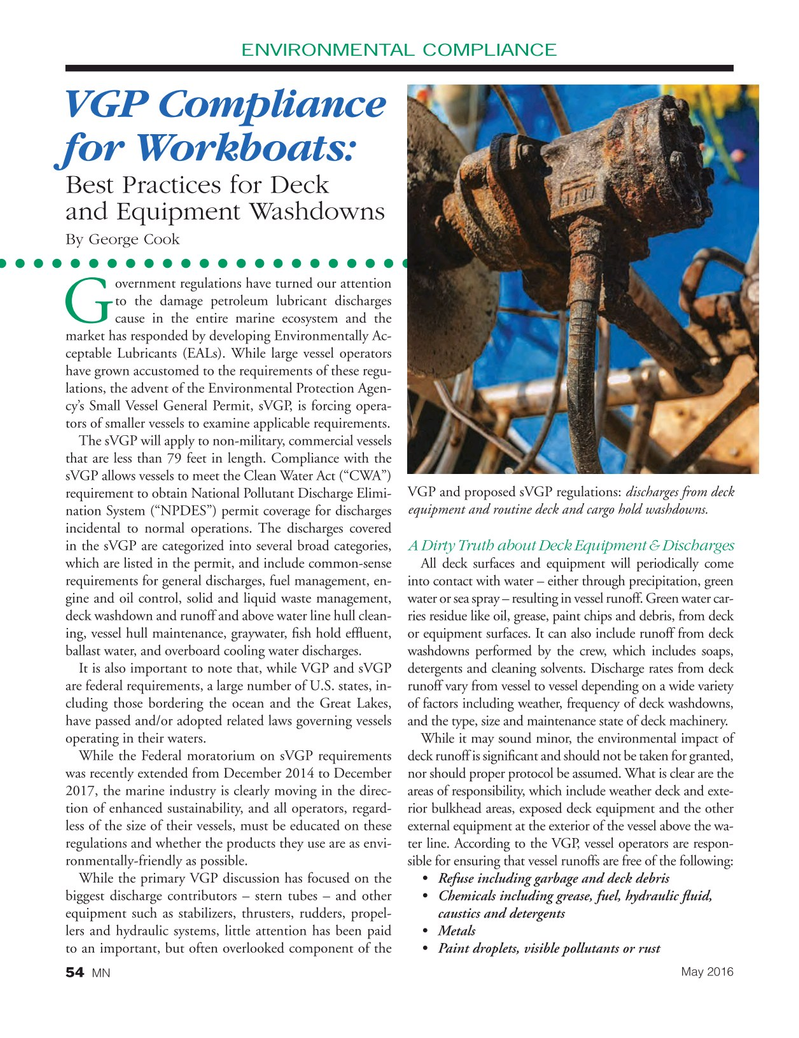
Page 54: of Marine News Magazine (May 2016)
Inland Waterways
Read this page in Pdf, Flash or Html5 edition of May 2016 Marine News Magazine
ENVIRONMENTAL COMPLIANCE
VGP Compliance for Workboats:
Best Practices for Deck and Equipment Washdowns
By George Cook overnment regulations have turned our attention to the damage petroleum lubricant discharges
G cause in the entire marine ecosystem and the market has responded by developing Environmentally Ac- ceptable Lubricants (EALs). While large vessel operators have grown accustomed to the requirements of these regu- lations, the advent of the Environmental Protection Agen- cy’s Small Vessel General Permit, sVGP, is forcing opera- tors of smaller vessels to examine applicable requirements.
The sVGP will apply to non-military, commercial vessels that are less than 79 feet in length. Compliance with the sVGP allows vessels to meet the Clean Water Act (“CWA”) requirement to obtain National Pollutant Discharge Elimi- VGP and proposed sVGP regulations: discharges from deck nation System (“NPDES”) permit coverage for discharges equipment and routine deck and cargo hold washdowns.
incidental to normal operations. The discharges covered in the sVGP are categorized into several broad categories,
A Dirty Truth about Deck Equipment & Discharges which are listed in the permit, and include common-sense All deck surfaces and equipment will periodically come requirements for general discharges, fuel management, en- into contact with water – either through precipitation, green gine and oil control, solid and liquid waste management, water or sea spray – resulting in vessel runoff. Green water car- deck washdown and runoff and above water line hull clean- ries residue like oil, grease, paint chips and debris, from deck ing, vessel hull maintenance, graywater, ? sh hold ef? uent, or equipment surfaces. It can also include runoff from deck ballast water, and overboard cooling water discharges. washdowns performed by the crew, which includes soaps,
It is also important to note that, while VGP and sVGP detergents and cleaning solvents. Discharge rates from deck are federal requirements, a large number of U.S. states, in- runoff vary from vessel to vessel depending on a wide variety cluding those bordering the ocean and the Great Lakes, of factors including weather, frequency of deck washdowns, have passed and/or adopted related laws governing vessels and the type, size and maintenance state of deck machinery.
operating in their waters. While it may sound minor, the environmental impact of
While the Federal moratorium on sVGP requirements deck runoff is signi? cant and should not be taken for granted, was recently extended from December 2014 to December nor should proper protocol be assumed. What is clear are the 2017, the marine industry is clearly moving in the direc- areas of responsibility, which include weather deck and exte- tion of enhanced sustainability, and all operators, regard- rior bulkhead areas, exposed deck equipment and the other less of the size of their vessels, must be educated on these external equipment at the exterior of the vessel above the wa- regulations and whether the products they use are as envi- ter line. According to the VGP, vessel operators are respon- ronmentally-friendly as possible. sible for ensuring that vessel runoffs are free of the following:
While the primary VGP discussion has focused on the • Refuse including garbage and deck debris biggest discharge contributors – stern tubes – and other • Chemicals including grease, fuel, hydraulic ? uid, equipment such as stabilizers, thrusters, rudders, propel- caustics and detergents lers and hydraulic systems, little attention has been paid • Metals to an important, but often overlooked component of the • Paint droplets, visible pollutants or rust
May 2016
MN 54
MN May16 Layout 52-65.indd 54 4/20/2016 10:40:08 AM

 53
53

 55
55
